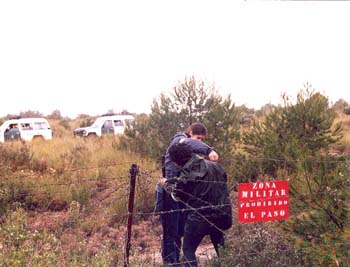|
Civil inspection of the Nato base in Valencia (Spain) by Antibase Thursday April 10, 2003 at 05:32 PM |
| cedsala@xarxaneta.org |
As it had openly been announced one month in advance, last Sunday 30th March, at about 12 a.m., several dozens of people named "citizen inspectors" crossed the wire fence of the base "Jaime I" in Bétera with the intention of performing a "civil inspection" of these military intallations that form part of the NATO.

inspeccio2__fernando_garc_a__peq.jpg, image/jpeg, 350x267
THE POLICE AND SOLDIERS BLOCKED THE CITIZEN INSPECTION OF THE NATO BASE IN BÉTERA (VALENCIA) BY FORCE.
As it had openly been announced one month in advance, last Sunday 30th March, at about 12 a.m., several dozens of people named "citizen inspectors" crossed the wire fence of the base "Jaime I" in Bétera (Valencia) with the intention of performing a "civil inspection" of these military intallations that form part of the NATO.
The goal of this action of civil disobedience promoted by the "Citizen Campaign against the NATO Base" was to prove that this military base forms part of the war mechanism and to demand its closing down and the return of the land to the Bétera village for its social use.
In order to achieve this, the inspectors would try to find mass destruction weapons inside the base itself and also information about the location of the nuclear armament the NATO and the US have at their disposal in European and North-American bases. They would also try to find attack plans on Iraq, and proofs of the support that is given from this type of installations to the military agression against the Iraqi population, such as the sending of a Spanish specialised brigade in protection against NBQ weapons in order to help the British and North-American troops.
Practically from the very moment the citizen inspectors left the meeting point in Bétera, a couple of hours before, the nearly 60 people (counting participants, journalists and supporting people ) that were heading for the military building were closely watched by Civil Guard agents. On the roads that surround the military base, off -road vehicles were placed every 500 metres, and a helicopter was overflying the area.
After a brief meeting to set "technical details" and last minute advice, the team of inspectors started walking under an increasingly intense rain on a track parallel to and very close to the wire fence that limits the base, on the opposite point to the place where the main dependencies of the base are. After 200 metres, and in spite of the proximity of several Civil Guard agents (who seemed surprised by the manoeuvre), the 40 components of the inspection group crossed the 15 metres that separated them from the wire fence. They placed themselves in a row and started to get inside between the wires with no opposition at all. After some minutes all the participants were on the other side, except for three of them that the Civil Guard agents grabbed by the arm.
Some seconds later, from other vehicles placed inside the base, several other agents got closer to stop the advance of the inspection team and they were informed that they were on military premises, that it was an illegal action and that they would be reported with the charge of breaking into a military installation if they didn't get out immediately, following the same way they had got inside.
The riot police command of the Civil Guard was in turn informed of the legitimacy of the objectives of the citizen inspection, and of the fact that the inspectors were aware of the illegality of the action, but that they had the intention of keeping on walking towards the military installations, (at a couple of kilometres from that point), unless they would physically not let them through. In any case, the inspection team had the intention of leaving the premises through the main door.
After this conversation, the inspection group started walking towards the building area of the base in parallel to the fence, so they would be seen from the outside of the premises. An escort made of six off-road Civil Guard vehicles and the military police was following the march just from behind. After walking about 500 metres, and at the point of reaching a secondary entrance that had been blocked by a barricade of barbed wire, the inspection team was forced to stop because a police cordon of about 50 agents was blocking the way completely on every way but the way out. The attempts of breaking the blockade with their hands up were responded by the agents requiring the identification of the inspectors. These, since it was impossible to continue, decided to start their lunch on the spot despite the muddy floor and the bad company.
Half an hour later, some part of the group of about 300 people that were on the main door arrived to the spot, and the inspectors decided to put an end to this inspection attempt, frustrated by the Civil Guard and the military police of the base. The inspectors then left the military premises one by one, hands up and among claps and shouts against wars. The lack of collaboration of the military authorities with the inspectors has convinced the latter that, behind that obscurity and secrecy, information of the type that they were looking for is really hidden, and that this information wouldn't resist public observation.
Once the inspectors were together with the supportive demonstrators, they announced that they would perform new attempts soon. In news reports published afterwards in written media, the Government local office and the Ministry of Defense assured that they would not report the participants of this action of civil disobedience.
Images and file on the civil inspection at:
http://www.antibase.org/modules.php?name=Content&pa=showpage&pid=161
www.antibase.org/modules.php?name=Content&pa=showpage&pid=161
